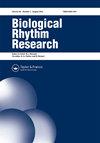Estimation of melatonin level and core body temperature: heart rate and heart rate variability as circadian rhythm markers
IF 0.9
4区 生物学
Q3 BIOLOGY
引用次数: 1
Abstract
ABSTRACT Because the circadian rhythm is different for each individual depending on what light environment they are exposed to on that day, the circadian rhythm needs to be constantly managed in everyday life. However, the typical circadian markers, changes in melatonin (MLT), and core body temperature (CBT) are difficult to measure 24-hour cycle of daily life. In this study, to propose relatively easy-to-monitor cardiac rhythmicity-related indicators as circadian markers, the biomarkers, including MLT, CBT, heart rate (HR), and heart rate variability (HRV), were collected from 22 Korean men. The MLT and CBT showed the largest positive correlation with R wave-to-R wave (RR) interval (Pearson’s r = .620, p < .001) and HR (Pearson’s r = .476, p < .001), respectively. In addition, the difference between the peak times of the seventh-order fitted MLT (adjusted R2 = .960, peak time 04:56) and RR interval (adjusted R2 = .960, peak time 04:35) was approximately 21 min; especially, the nadir times of the fitted CBT (adjusted R2 = .961, nadir time 04:55) and HR (adjusted R2 = .934, nadir time 04:52) were almost the same. Therefore, we can confidently say that HR and RR intervals are good indicators for estimating an individual’s circadian rhythm.褪黑激素水平和核心体温的估计:心率和心率变异性作为昼夜节律标志
由于每个人的昼夜节律取决于他们当天所处的光环境,因此在日常生活中需要不断地管理昼夜节律。然而,典型的昼夜节律标志,褪黑激素(MLT)变化和核心体温(CBT)难以测量日常生活的24小时周期。在这项研究中,为了提出相对容易监测的心律相关指标作为昼夜节律标志物,我们收集了22名韩国男性的生物标志物,包括MLT、CBT、心率(HR)和心率变异性(HRV)。MLT和CBT分别与R波-R波(RR)间隔(Pearson’s R = 0.620, p < 0.001)和HR (Pearson’s R = 0.476, p < 0.001)呈正相关。此外,七阶拟合MLT的峰值时间(调整R2 = 0.960,峰值时间04:56)与RR间隔(调整R2 = 0.960,峰值时间04:35)的差异约为21 min;其中,拟合CBT(调整R2 = .961,最低点时间04:55)和HR(调整R2 = .934,最低点时间04:52)的最低点时间几乎相同。因此,我们可以自信地说,HR和RR间隔是估计个体昼夜节律的良好指标。
本文章由计算机程序翻译,如有差异,请以英文原文为准。
求助全文
约1分钟内获得全文
求助全文
来源期刊

Biological Rhythm Research
生物-生理学
CiteScore
3.00
自引率
9.10%
发文量
34
审稿时长
6-12 weeks
期刊介绍:
The principal aim of Biological Rhythm Research is to cover any aspect of research into the broad topic of biological rhythms. The area covered can range from studies at the genetic or molecular level to those of behavioural or clinical topics. It can also include ultradian, circadian, infradian or annual rhythms. In this way, the Editorial Board tries to stimulate interdisciplinary rhythm research. Such an aim reflects not only the similarity of the methods used in different fields of chronobiology, but also the fact that many influences that exert controlling or masking effects are common. Amongst the controlling factors, attention is paid to the effects of climate change on living organisms. So, papers dealing with biometeorological aspects can also be submitted.
The Journal publishes original scientific research papers, review papers, short notes on research in progress, book reviews and summaries of activities, symposia and congresses of national and international organizations dealing with rhythmic phenomena.
 求助内容:
求助内容: 应助结果提醒方式:
应助结果提醒方式:


